park assist VOLVO XC90 TWIN ENGINE 2019 Owners Manual
[x] Cancel search | Manufacturer: VOLVO, Model Year: 2019, Model line: XC90 TWIN ENGINE, Model: VOLVO XC90 TWIN ENGINE 2019Pages: 697, PDF Size: 10.33 MB
Page 11 of 697
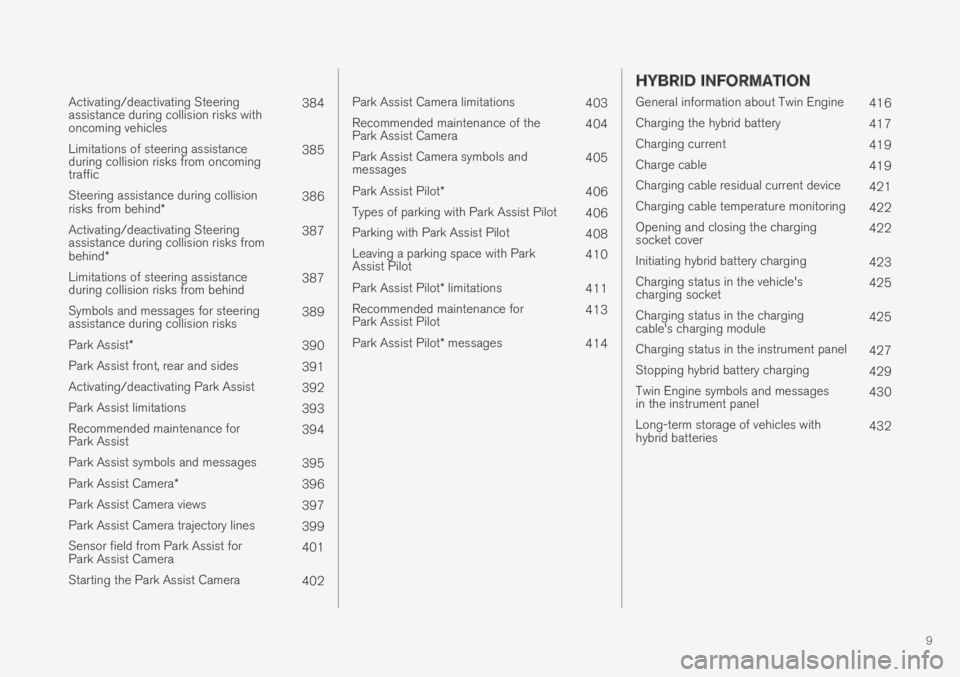
9
Activating/deactivating Steeringassistance during collision risks withoncoming vehicles
384
Limitations of steering assistanceduring collision risks from oncomingtraffic
385
Steering assistance during collisionrisks from behind*386
Activating/deactivating Steeringassistance during collision risks frombehind*
387
Limitations of steering assistanceduring collision risks from behind387
Symbols and messages for steeringassistance during collision risks389
Park Assist*390
Park Assist front, rear and sides391
Activating/deactivating Park Assist392
Park Assist limitations393
Recommended maintenance forPark Assist394
Park Assist symbols and messages395
Park Assist Camera*396
Park Assist Camera views397
Park Assist Camera trajectory lines399
Sensor field from Park Assist forPark Assist Camera401
Starting the Park Assist Camera402
Park Assist Camera limitations403
Recommended maintenance of thePark Assist Camera404
Park Assist Camera symbols andmessages405
Park Assist Pilot* 406
Types of parking with Park Assist Pilot406
Parking with Park Assist Pilot408
Leaving a parking space with ParkAssist Pilot410
Park Assist Pilot* limitations 411
Recommended maintenance forPark Assist Pilot413
Park Assist Pilot* messages414
HYBRID INFORMATION
General information about Twin Engine416
Charging the hybrid battery417
Charging current419
Charge cable419
Charging cable residual current device421
Charging cable temperature monitoring422
Opening and closing the chargingsocket cover422
Initiating hybrid battery charging423
Charging status in the vehicle'scharging socket425
Charging status in the chargingcable's charging module425
Charging status in the instrument panel427
Stopping hybrid battery charging429
Twin Engine symbols and messagesin the instrument panel430
Long-term storage of vehicles withhybrid batteries432
Page 12 of 697
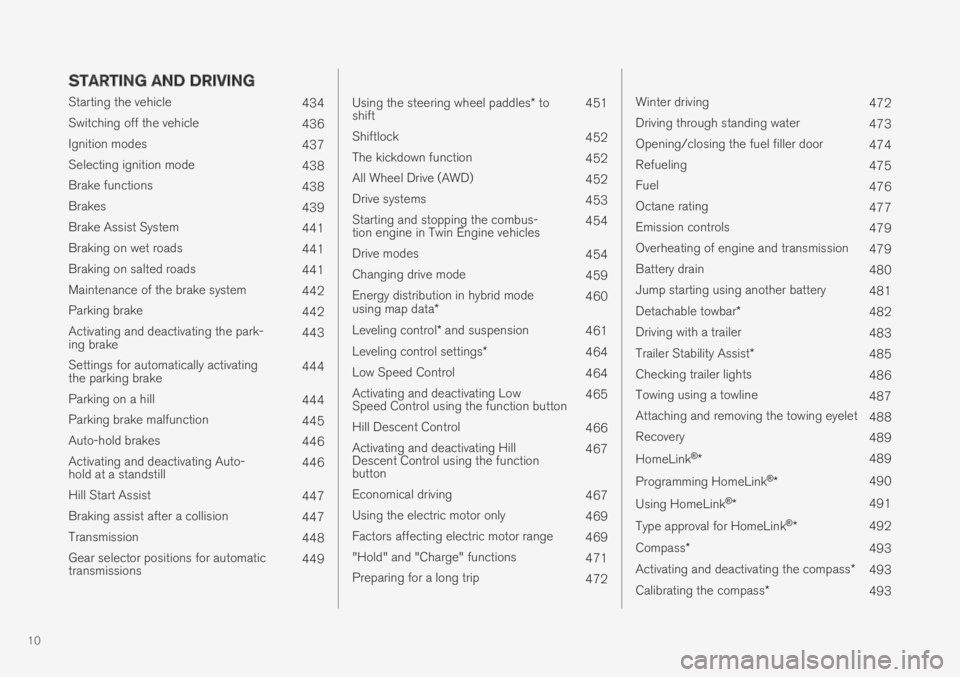
10
STARTING AND DRIVING
Starting the vehicle434
Switching off the vehicle436
Ignition modes437
Selecting ignition mode438
Brake functions438
Brakes439
Brake Assist System441
Braking on wet roads441
Braking on salted roads441
Maintenance of the brake system442
Parking brake442
Activating and deactivating the park-ing brake443
Settings for automatically activatingthe parking brake444
Parking on a hill444
Parking brake malfunction445
Auto-hold brakes446
Activating and deactivating Auto-hold at a standstill446
Hill Start Assist447
Braking assist after a collision447
Transmission448
Gear selector positions for automatictransmissions449
Using the steering wheel paddles* toshift451
Shiftlock452
The kickdown function452
All Wheel Drive (AWD)452
Drive systems453
Starting and stopping the combus-tion engine in Twin Engine vehicles454
Drive modes454
Changing drive mode459
Energy distribution in hybrid modeusing map data*460
Leveling control* and suspension461
Leveling control settings*464
Low Speed Control464
Activating and deactivating LowSpeed Control using the function button465
Hill Descent Control466
Activating and deactivating HillDescent Control using the functionbutton
467
Economical driving467
Using the electric motor only469
Factors affecting electric motor range469
"Hold" and "Charge" functions471
Preparing for a long trip472
Winter driving472
Driving through standing water473
Opening/closing the fuel filler door474
Refueling475
Fuel476
Octane rating477
Emission controls479
Overheating of engine and transmission479
Battery drain480
Jump starting using another battery481
Detachable towbar*482
Driving with a trailer483
Trailer Stability Assist*485
Checking trailer lights486
Towing using a towline487
Attaching and removing the towing eyelet488
Recovery489
HomeLink®*489
Programming HomeLink®*490
Using HomeLink®*491
Type approval for HomeLink®*492
Compass*493
Activating and deactivating the compass*493
Calibrating the compass*493
Page 30 of 697

||
YOUR VOLVO
* Option/accessory.28
goal. In addition to continuous environmentalrefinement of conventional gasoline-poweredinternal combustion engines, Volvo is activelylooking at advanced technology alternative-fuelvehicles.
When you drive a Volvo, you become our partnerin the work to lessen the vehicle's impact on theenvironment. To reduce your vehicle's environ-mental impact, you can:
Maintain proper air pressure in your tires.Tests have shown decreased fuel economywith improperly inflated tires.
Follow the recommended maintenanceschedule in your Warranty and ServiceRecords Information booklet.
Drive at a constant speed whenever possible.
See a trained and qualified Volvo servicetechnician as soon as possible for inspectionif the check engine (malfunction indicator)light illuminates, or stays on after the vehiclehas started.
Properly dispose of any vehicle-related wastesuch as used motor oil, used batteries, brakepads, etc.
When cleaning your vehicle, please use gen-uine Volvo car care products. All Volvo carcare products are formulated to be environ-mentally friendly.
Twin Engine vehicles
If possible, precondition the vehicle with thecharging cable before driving.
If preconditioning is not possible in coldweather, use the seat and steering wheelheating primarily. Avoid heating the entirepassenger compartment, which reduces thehybrid battery's charge level.
Choose the Pure drive mode to help mini-mize electric power consumption.
In hilly terrain, put the gear selector in modeB to utilize the electric motor's braking func-tion when the accelerator pedal is released.This helps charge the hybrid battery.
Related information
Economical driving (p. 467)
Starting and stopping preconditioning(p. 233)
The Owner's Manual and the environment(p. 24)
Air quality (p. 206)
IntelliSafe - driver support
IntelliSafe is Volvo Cars' philosophy regardingvehicle safety. IntelliSafe consists of a number ofsystems, both standard and optional, that aredesigned to help make driving safer, preventaccidents and protect passengers and otherroad users.
Support
IntelliSafe includes driver support functions suchas Adaptive cruise control* which helps the driverto maintain an even speed combined with a pre-selected time interval to the vehicle ahead.
Pilot Assist2 helps the driver keep the vehicle inthe current traffic lane by providing steeringassistance and maintaining an even speed and aset time interval to the vehicle ahead.
Park Assist Pilot* helps the driver pull into andout of parking spaces.
Other examples of systems that can help thedriver are the Active main beam, Cross TrafficAlert (CTA)* and Blind Spot Information (BLIS)*systems.
Prevention
City Safety is a function intended to help preventaccidents. The function can help prevent or miti-gate a collision with pedestrians, cyclists, largeanimals or other vehicles. Light, sound and pulsa-tions in the brake pedal are provided to alert of a
2Depending on market, this function can be either standard or optional.
Page 42 of 697
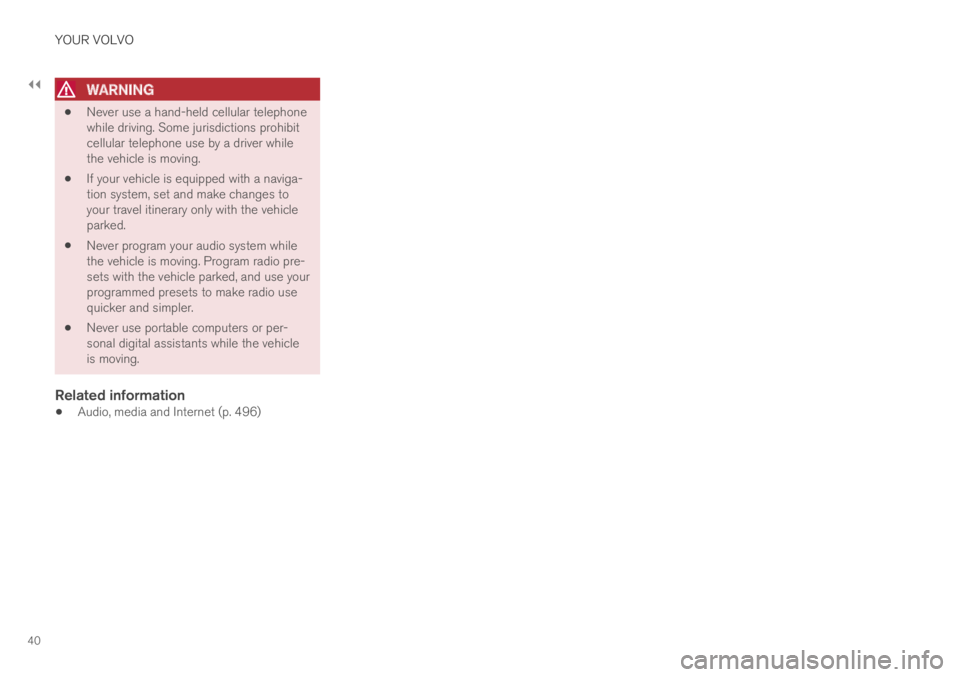
||
YOUR VOLVO
40
WARNING
Never use a hand-held cellular telephonewhile driving. Some jurisdictions prohibitcellular telephone use by a driver whilethe vehicle is moving.
If your vehicle is equipped with a naviga-tion system, set and make changes toyour travel itinerary only with the vehicleparked.
Never program your audio system whilethe vehicle is moving. Program radio pre-sets with the vehicle parked, and use yourprogrammed presets to make radio usequicker and simpler.
Never use portable computers or per-sonal digital assistants while the vehicleis moving.
Related information
Audio, media and Internet (p. 496)
Page 119 of 697
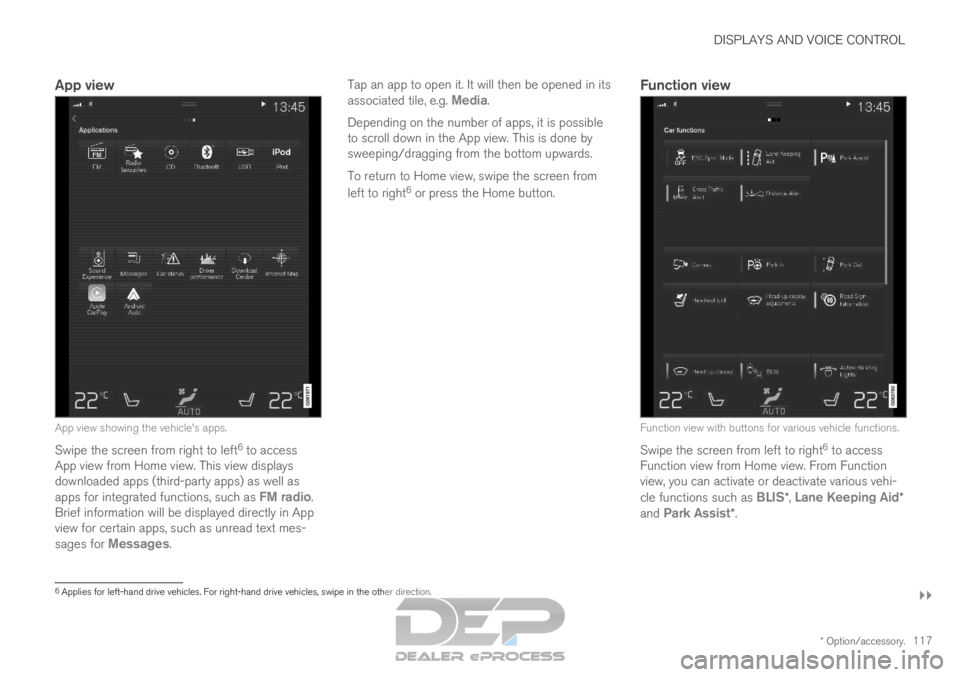
DISPLAYS AND VOICE CONTROL
}}
* Option/accessory. 117
App viewApp view showing the vehicle's apps.
Swipe the screen from right to left 6
to access
App view from Home view. This view displays
downloaded apps (third-party apps) as well as
apps for integrated functions, such as FM radio.
Brief information will be displayed directly in App
view for certain apps, such as unread text mes-
sages for Messages. Tap an app to open it. It will then be opened in its
associated tile, e.g.
Media.
Depending on the number of apps, it is possible
to scroll down in the App view. This is done by
sweeping/dragging from the bottom upwards.
To return to Home view, swipe the screen from
left to right 6
or press the Home button.Function view Function view with buttons for various vehicle functions.
Swipe the screen from left to right 6
to access
Function view from Home view. From Function
view, you can activate or deactivate various vehi-
cle functions such as BLIS*, Lane Keeping Aid*
and Park Assist*. 6
Applies for left-hand drive vehicles. For right-hand drive vehicles, swi\
pe in the other direction.
Page 280 of 697
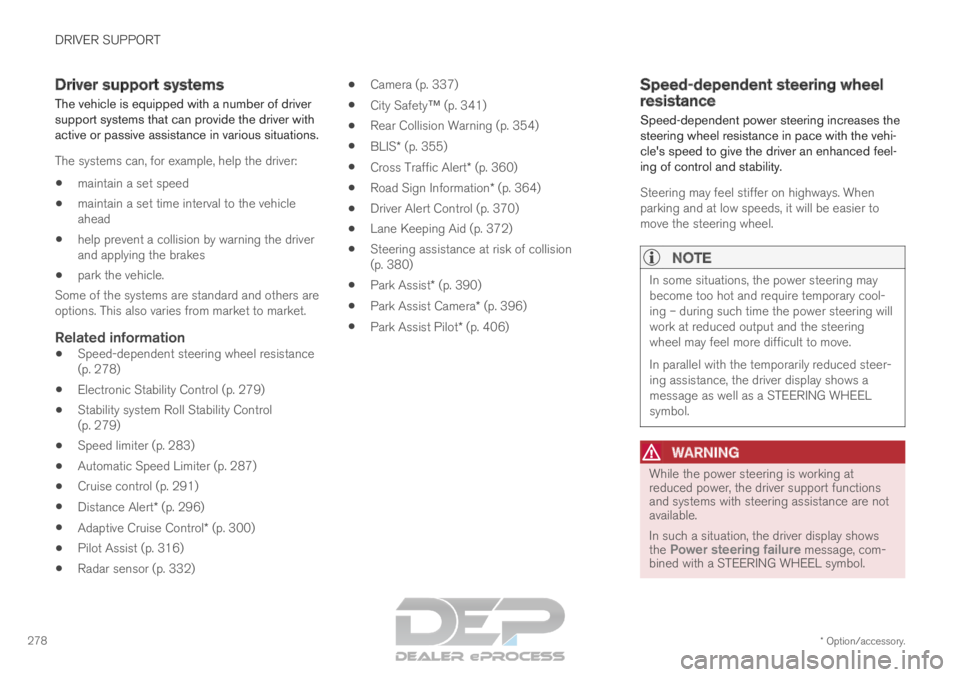
DRIVER SUPPORT
* Option/accessory.
278 Driver support systems
The vehicle is equipped with a number of driver
support systems that can provide the driver with
active or passive assistance in various situations.
The systems can, for example, help the driver:
maintain a set speed
maintain a set time interval to the vehicle
ahead
help prevent a collision by warning the driver
and applying the brakes
park the vehicle.
Some of the systems are standard and others are
options. This also varies from market to market.
Related information
Speed-dependent steering wheel resistance
(p. 278)
Electronic Stability Control (p. 279)
Stability system Roll Stability Control
(p. 279)
Speed limiter (p. 283)
Automatic Speed Limiter (p. 287)
Cruise control (p. 291)
Distance Alert* (p. 296)
Adaptive Cruise Control* (p. 300)
Pilot Assist (p. 316)
Radar sensor (p. 332)
Camera (p. 337)
City Safety™ (p. 341)
Rear Collision Warning (p. 354)
BLIS* (p. 355)
Cross Traffic Alert* (p. 360)
Road Sign Information* (p. 364)
Driver Alert Control (p. 370)
Lane Keeping Aid (p. 372)
Steering assistance at risk of collision
(p. 380)
Park Assist* (p. 390)
Park Assist Camera* (p. 396)
Park Assist Pilot* (p. 406) Speed-dependent steering wheel
resistance
Speed-dependent power steering increases the
steering wheel resistance in pace with the vehi-
cle's speed to give the driver an enhanced feel-
ing of control and stability.
Steering may feel stiffer on highways. When
parking and at low speeds, it will be easier to
move the steering wheel.
NOTE In some situations, the power steering may
become too hot and require temporary cool-
ing – during such time the power steering will
work at reduced output and the steering
wheel may feel more difficult to move.
In parallel with the temporarily reduced steer-
ing assistance, the driver display shows a
message as well as a STEERING WHEEL
symbol.
WARNING
While the power steering is working at
reduced power, the driver support functions
and systems with steering assistance are not
available.
In such a situation, the driver display shows
the
Power steering failure message, com-
bined with a STEERING WHEEL symbol.
Page 281 of 697
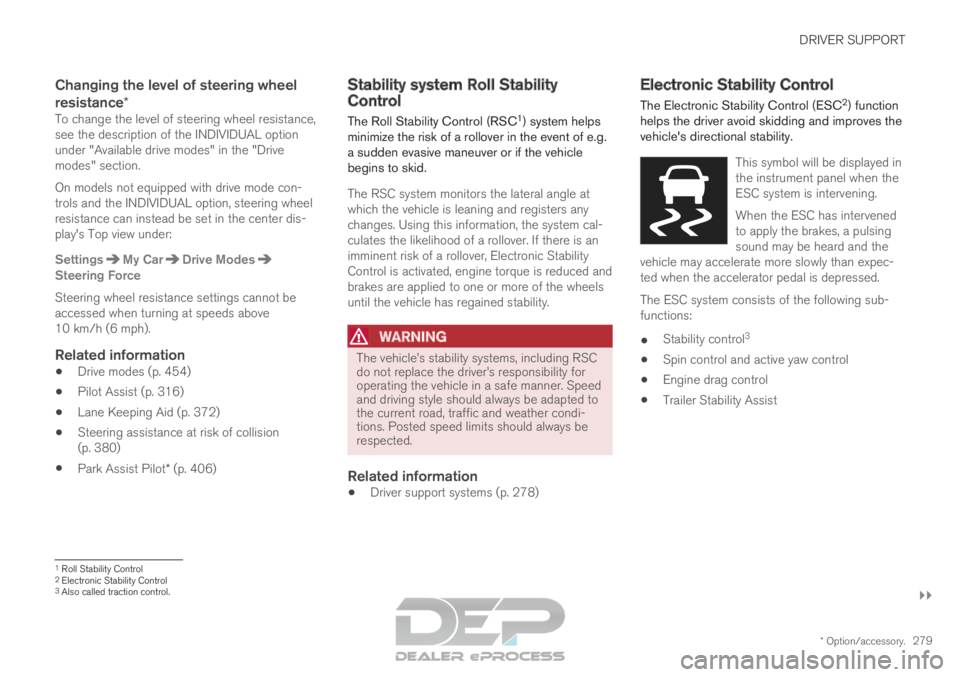
DRIVER SUPPORT
}}
* Option/accessory. 279
Changing the level of steering wheel
resistance*
To change the level of steering wheel resistance,
see the description of the INDIVIDUAL option
under "Available drive modes" in the "Drive
modes" section.
On models not equipped with drive mode con-
trols and the INDIVIDUAL option, steering wheel
resistance can instead be set in the center dis-
play's Top view under:
Settings My Car Drive Modes
Steering Force
Steering wheel resistance settings cannot be
accessed when turning at speeds above
10 km/h (6 mph).
Related information
Drive modes (p. 454)
Pilot Assist (p. 316)
Lane Keeping Aid (p. 372)
Steering assistance at risk of collision
(p. 380)
Park Assist Pilot* (p. 406) Stability system Roll Stability
Control
The Roll Stability Control (RSC 1
) system helps
minimize the risk of a rollover in the event of e.g.
a sudden evasive maneuver or if the vehicle
begins to skid.
The RSC system monitors the lateral angle at
which the vehicle is leaning and registers any
changes. Using this information, the system cal-
culates the likelihood of a rollover. If there is an
imminent risk of a rollover, Electronic Stability
Control is activated, engine torque is reduced and
brakes are applied to one or more of the wheels
until the vehicle has regained stability.
WARNING The vehicle
Page 312 of 697

DRIVER SUPPORT
* Option/accessory.
310 Starting passing assistance with
Adaptive Cruise Control
Several conditions must be met for passing
assistance to be possible.
Requirements for passing assistanceIn order to activate passing assistance:
your vehicle must be following a vehicle
ahead (target vehicle)
your vehicle's current speed must be
at least 70 km/h (43 mph)
the set speed for ACC must be high
enough to safely pass another vehicle.
Starting parking assistanceTo start passing assistance:
–
Turn on the left turn signal.
>
Passing assistance will start.
Related information
Adaptive Cruise Control* (p. 300)
Passing assistance with Adaptive Cruise
Control (p. 309) Limitations of passing assistance
with Adaptive Cruise Control
Passing assistance functionality may be reduced
in certain situations.
WARNING The driver should be aware that if conditions
suddenly change when using Parking Assis-
tance, the function may implement an unde-
sired acceleration in certain conditions.
Some situations should be avoided, e.g. if:
the vehicle is approaching an exit in the
same direction as passing would normally
occur
the vehicle ahead slows before your vehi-
cle has had time to switch to the passing
lane
traffic in the passing lane slows down
a vehicle for right-hand traffic is driven in
a country with left-hand traffic (or vice
versa).
Situations of this type can be avoided by tempo-
rarily putting ACC 50
in standby mode.
Related information
Adaptive Cruise Control* (p. 300)
Passing assistance with Adaptive Cruise
Control (p. 309) Switching target vehicles with
Adaptive Cruise Control
At certain speeds, models with automatic trans-
missions and Adaptive Cruise Control (ACC 51
)
can switch target vehicles.
Switching target vehicles If the target vehicle ahead turns suddenly, there may be
stationary traffic ahead.
When Adaptive Cruise Control is actively follow-
ing another vehicle at speeds under 30 km/h
(20 mph) and switches targets from a moving
vehicle to a stationary vehicle, Adaptive Cruise
Control will brake for the stationary vehicle. 50
Adaptive Cruise Control
Page 327 of 697
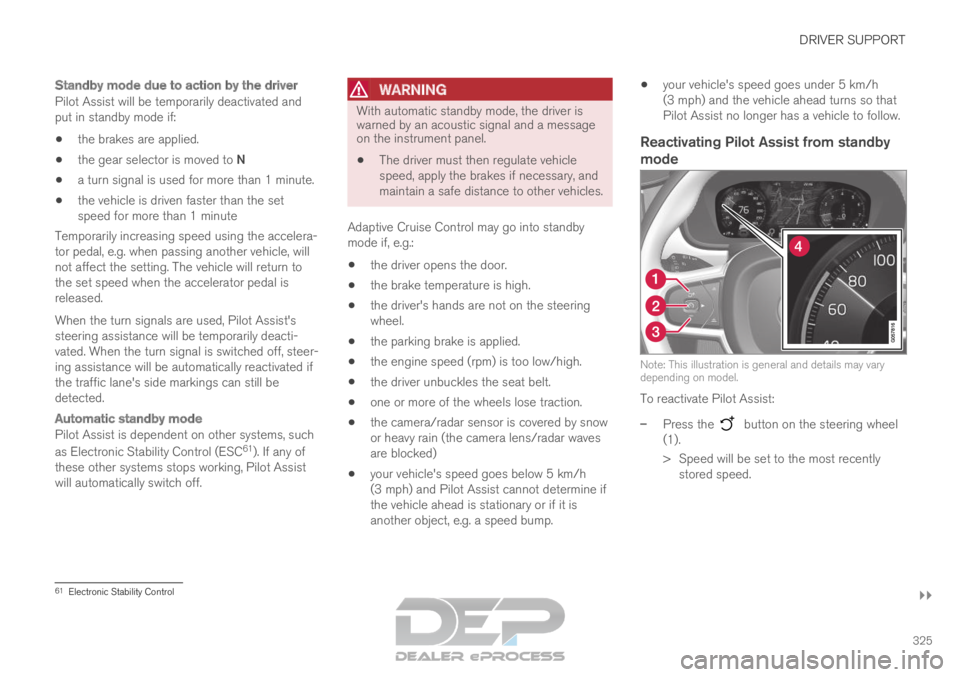
DRIVER SUPPORT
}}
325
Standby mode due to action by the driver
Pilot Assist will be temporarily deactivated and
put in standby mode if: the brakes are applied.
the gear selector is moved to N
a turn signal is used for more than 1 minute.
the vehicle is driven faster than the set
speed for more than 1 minute
Temporarily increasing speed using the accelera-
tor pedal, e.g. when passing another vehicle, will
not affect the setting. The vehicle will return to
the set speed when the accelerator pedal is
released.
When the turn signals are used, Pilot Assist's
steering assistance will be temporarily deacti-
vated. When the turn signal is switched off, steer-
ing assistance will be automatically reactivated if
the traffic lane's side markings can still be
detected.
Automatic standby mode
Pilot Assist is dependent on other systems, such
as Electronic Stability Control (ESC 61
). If any of
these other systems stops working, Pilot Assist
will automatically switch off.
WARNING With automatic standby mode, the driver is
warned by an acoustic signal and a message
on the instrument panel.
The driver must then regulate vehicle
speed, apply the brakes if necessary, and
maintain a safe distance to other vehicles.
Adaptive Cruise Control may go into standby
mode if, e.g.:
the driver opens the door.
the brake temperature is high.
the driver's hands are not on the steering
wheel.
the parking brake is applied.
the engine speed (rpm) is too low/high.
the driver unbuckles the seat belt.
one or more of the wheels lose traction.
the camera/radar sensor is covered by snow
or heavy rain (the camera lens/radar waves
are blocked)
your vehicle's speed goes below 5 km/h
(3 mph) and Pilot Assist cannot determine if
the vehicle ahead is stationary or if it is
another object, e.g. a speed bump.
your vehicle's speed goes under 5 km/h
(3 mph) and the vehicle ahead turns so that
Pilot Assist no longer has a vehicle to follow.
Reactivating Pilot Assist from standby
mode Note: This illustration is general and details may vary
depending on model.
To reactivate Pilot Assist:
–
Press the button on the steering wheel
(1).
>
Speed will be set to the most recently
stored speed. 61
Electronic Stability Control
Page 329 of 697
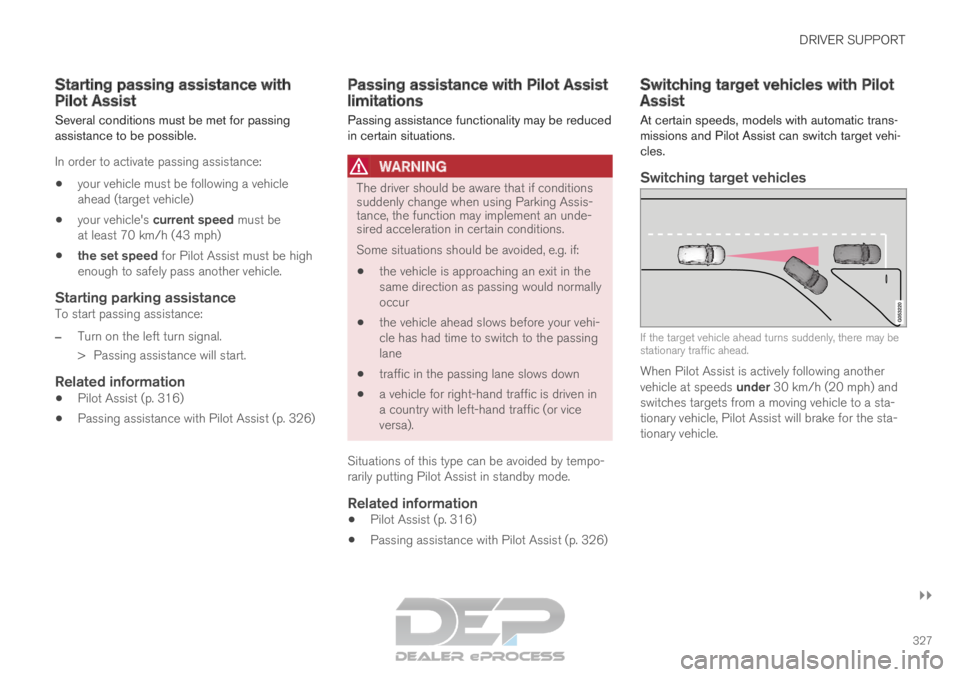
DRIVER SUPPORT
}}
327
Starting passing assistance with
Pilot Assist
Several conditions must be met for passing
assistance to be possible.
In order to activate passing assistance:
your vehicle must be following a vehicle
ahead (target vehicle)
your vehicle's current speed must be
at least 70 km/h (43 mph)
the set speed for Pilot Assist must be high
enough to safely pass another vehicle.
Starting parking assistanceTo start passing assistance:
–
Turn on the left turn signal.
>
Passing assistance will start.
Related information
Pilot Assist (p. 316)
Passing assistance with Pilot Assist (p. 326) Passing assistance with Pilot Assist
limitations
Passing assistance functionality may be reduced
in certain situations.
WARNING The driver should be aware that if conditions
suddenly change when using Parking Assis-
tance, the function may implement an unde-
sired acceleration in certain conditions.
Some situations should be avoided, e.g. if:
the vehicle is approaching an exit in the
same direction as passing would normally
occur
the vehicle ahead slows before your vehi-
cle has had time to switch to the passing
lane
traffic in the passing lane slows down
a vehicle for right-hand traffic is driven in
a country with left-hand traffic (or vice
versa).
Situations of this type can be avoided by tempo-
rarily putting Pilot Assist in standby mode.
Related information
Pilot Assist (p. 316)
Passing assistance with Pilot Assist (p. 326) Switching target vehicles with Pilot
Assist
At certain speeds, models with automatic trans-
missions and
Pilot Assist can switch target vehi-
cles.
Switching target vehicles If the target vehicle ahead turns suddenly, there may be
stationary traffic ahead.
When Pilot Assist is actively following another
vehicle at speeds under 30 km/h (20 mph) and
switches targets from a moving vehicle to a sta-
tionary vehicle,
Pilot Assist will brake for the sta-
tionary vehicle.